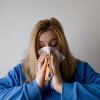Antibiotics that grow on trees
Interview with
科学家们发现了一个声明new family of antimicrobial compounds that are produced by the Australian blushwood tree is welcome news in the fight against a rising tide of antibiotic resistance. Very few new antibiotic drugs have been developed in recent years, for various reasons, meaning that we’re in increasing danger of succumbing to infections we can no longer treat. In tests, the new agents kill a broad swathe of disease-causing bacteria; they are also very effective at dismantling the protective “biofilm” that bacterial communities build to defend themselves from drugs and the immune system, meaning they can help make bacteria vulnerable to other antibiotics, and they boost the immune response and healing power of the tissue at wound sites. Speaking with Chris Smith, and from the QIMR Berghofer Medical Research Institute, Jason Cullen…
Jason - Essentially what these molecules do is they disrupt these biofilm structures, but then they can also stimulate a very good immune response, which enables a wound to sort of reset itself. And then you get a good wound healing response.
Chris - Tell us a bit more about these compounds then where do they come from?
Jason - One of our collaborators was quite interested in deriving therapeutics from the Australian rainforest. They came across these compounds initially as oncology agents, but, it turns out that they also work quite well in chronic wounds. They're derived from an Australian rainforest tree’s fruit and nuts.
Chris - What does the plant do with these compounds? Why does it make them?
Jason - They act as a bit of a deterrent to animals on the floor. So when the fruit drops off the tree, they'll eat the fruit, but then end up leaving the nut alone. But they may also have other benefits within the seed itself in order to stop any microbial sort of degradation of the nut.
Chris - How did you pursue it then? Once you had these compounds, how did you start to try to piece together what they could do against microbes?
Jason - Originally. It wasn't anything to do with microbes, but what my collaborators noticed is that one of these, similar looking compounds, which is being used to treat tumours. After it treated the tumour, you got this very nice wound healing response. There was also data from veterinary studies suggesting that this class of compound could actually close hard to heal wounds in animals. And so we set about just trying to understand if they would have some applicability in chronic wounds in the lab and ultimately help develop this for human applications.
Chris - So if it promotes wound healing, is it doing that just because it suppresses invading microorganisms that irritate the wound, or is it also doing something to the animal tissue that makes that more likely to heal?
Jason - Yeah, we think they work by a number of different mechanisms. One of them is that it appears to disrupt the bacterial biofilm. They're not actually antibiotic in a sense that they don't actually directly kill the bacteria, but they just disrupt these structures. And the other activities that we found here is that they can also stimulate a very good immune response. In addition to that, they seem to induce changes in these skin resident cells, which promotes a very good sort of wound healing response. So we think it's a mixture of all of these activities, which come together to help promote the closure of wounds.
Chris - Do they work against all classes of bugs or are they quite discreet because different horses run on different courses when it comes to antibiotics and some are very good at treating some classes of microbes and absolutely useless against others. Is this a comprehensive effect or are they quite focused?
Jason - We found that the actual main one that we're interested in can actually disrupt a lot of Gram-negative and some Gram-positive biofilms as well. Obviously they don't work on everything, but there's quite a broad selection that they do work on.
Chris - And the resistance problem. I mean, that's ostensibly why you are going down this path.
Jason - Yeah. So we think that these will help sort of circumvent the resistance problem because they're targeting bacterial virulence rather than the growth or survival of the bacteria. So in that sense, it sort of reduces the potential for the development of antibiotic resistance.
- PreviousWelcome to Trieste!
- NextA new self sterilising plastic









Comments
Add a comment